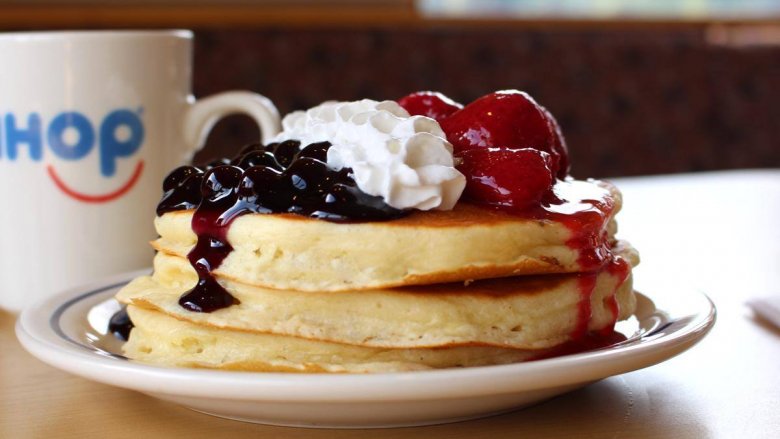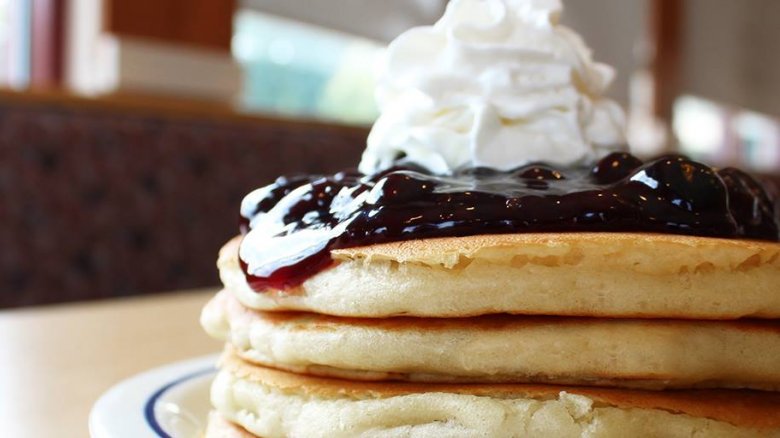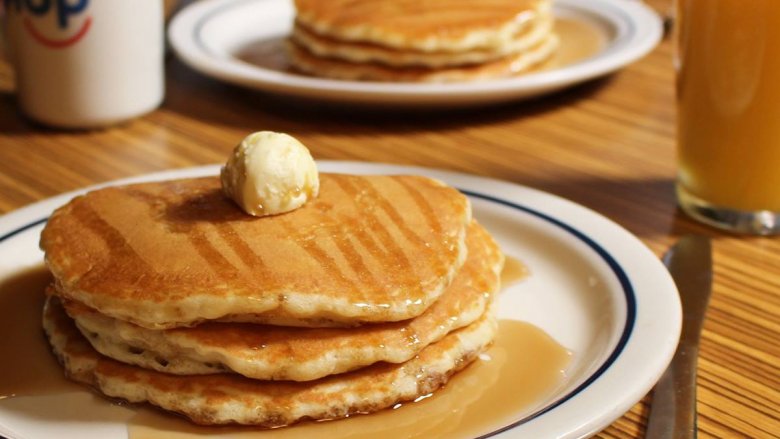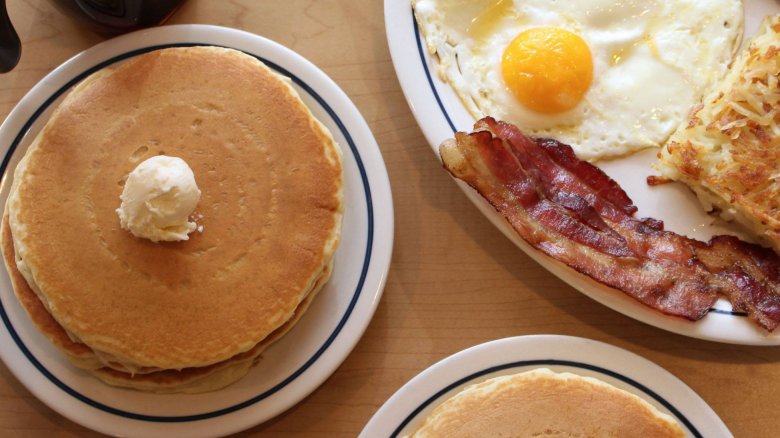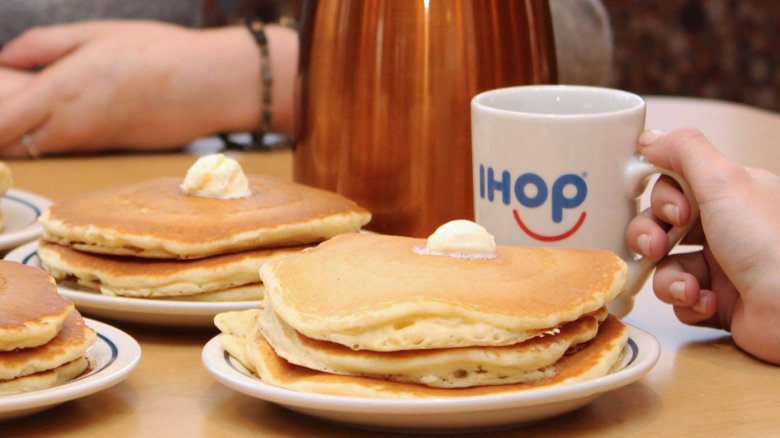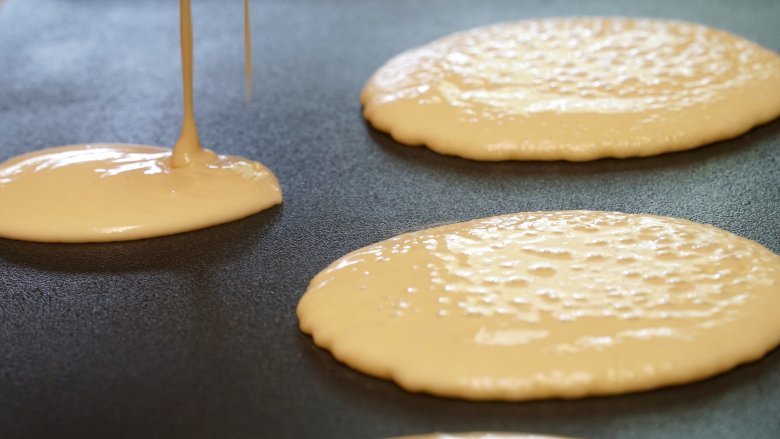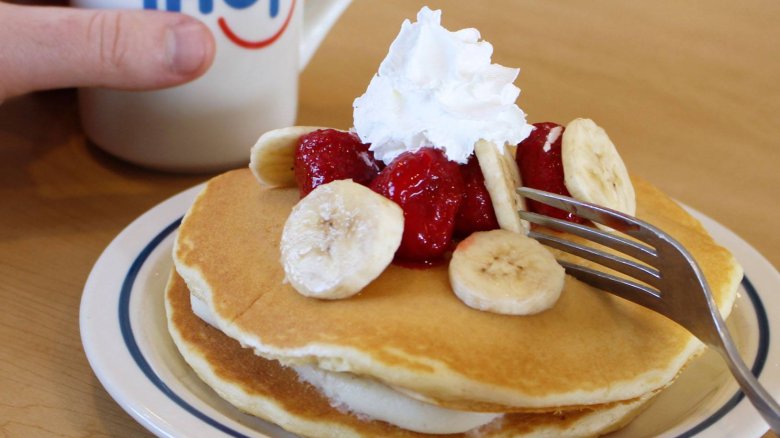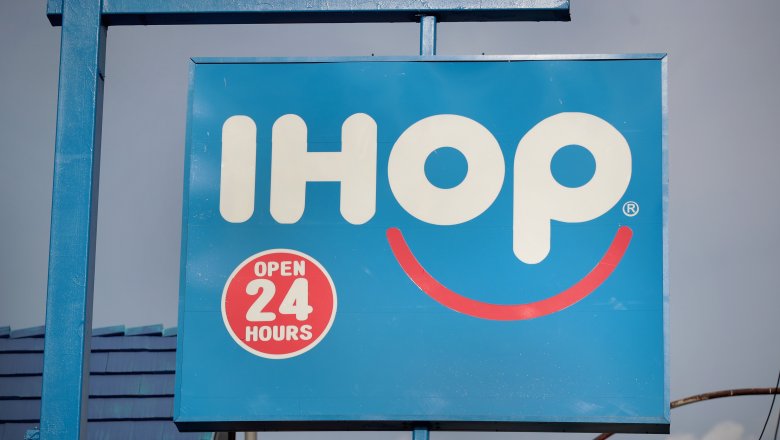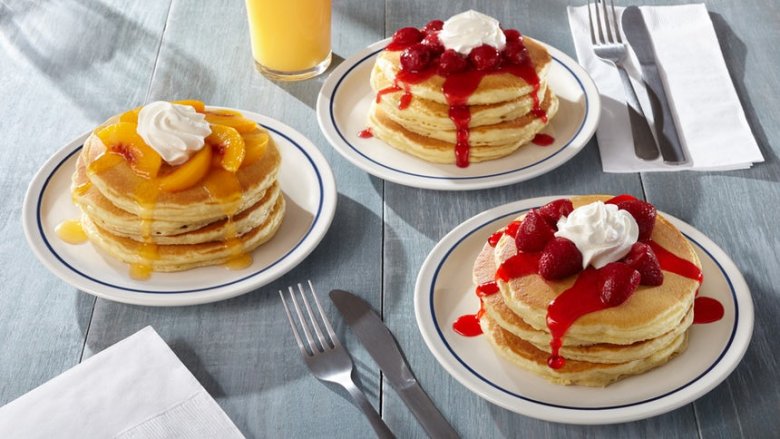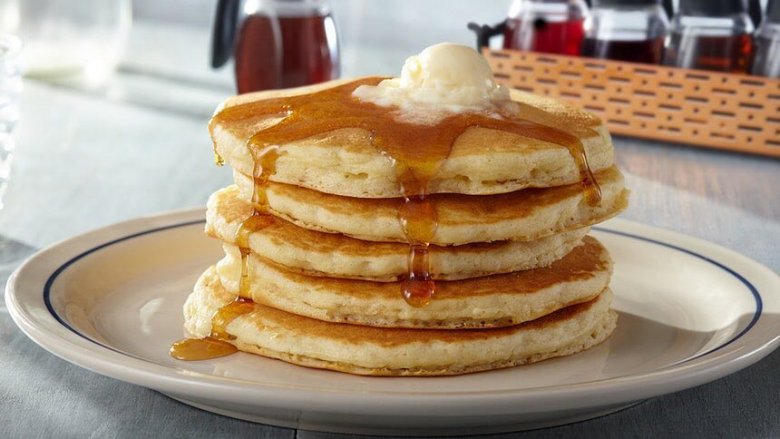This Is Why IHOP's Pancakes Are So Delicious
By this point you're probably aware that IHOP's pancakes are legit, which makes sense — if you're going to call yourself the International House of Pancakes, you'd better deliver on those pancakes. The chain diner, which didn't embrace the acronym IHOP until 15 years after it first opened, is popular with early birds and night owls alike (most of the restaurants are open 24 hours), and you'd better believe both groups are ordering stacks of pancakes. Is there anything better than breakfast for dinner?
In fact, IHOP serves a whopping 700 million pancakes every year, which is not only a jaw-dropping number, but also a testament to just how good the 'cakes are under those iconic blue roofs. If you need more convincing, the pancake batter is so good they even add it to the scrambled eggs and omelettes. What makes their flapjack stacks so special? We uncovered some pancake intel to really get to the bottom of the hype.
The batter's liquid ingredients are ice cold
When you're baking a cake, the recipe usually calls for room temperature eggs or butter. Apparently, you should not assume it's the same protocol when you're trying to make great pancakes. IHOP's vice president of culinary innovation Marie Grimm told Delish that any liquid going into their pancake batter is always very cold, and it turns out that's a crucial thing. That's because when the liquid ingredients in a batch of batter are warm or room temperature, they cause a chemical reaction by raising the temperature of the gluten in the flour, which gives a springy quality to the 'cakes a little too soon.
So, presumably, IHOP chefs don't pull their liquid necessities out of the fridge until it's time to mix with the dry stuff. We'd imagine that the busy diner kitchen gets pretty steamy at peak breakfast hours so if ice cold eggs, milk, and butter are what's needed for stellar pancakes, by all means keep them chilled as long as possible.
We always knew the texture of an IHOP pancake was spot-on, but now we know why.
They don't use butter or oil on the griddle
This might surprise you but when it comes to IHOP pancakes, butter does not make everything better, at least during the cooking process. The culinary innovation VP from IHOP, Marie Grimm, informed Delish that using butter or oil to grease the griddle messes with the perfect finished pancake that IHOP seems to have mastered, and instead results in more of a "webbed, lacy" look that just isn't going to be as visually appealing as that smooth golden-brown surface we've come to know and love.
The problem with butter is that it burns easily, so if you've got a griddle on a hot temperature for long amounts of time, or are making a large batch of pancakes, you might end up cooking on residual brown milk solids from the butter breaking down. That burnt butter flavor can potentially overcome the rest of the flavors. With oil, there's a risk for dark, uneven spots on the 'cakes, which isn't necessarily a bad thing but not on par with what you expect at IHOP.
When you're wanting that certain pancake experience that only IHOP can deliver, and if your love of the pancakes begins with that first gaze onto their perfect pancake color, they can really only give it to you when they nix both butter and oil in the cooking process. Thankfully, they do save the butter for the top of the stack.
The pancakes never share their griddle
If you want good pancakes, you gotta be stingy with the griddle. In the case of the IHOP kitchen, there are two stations designated solely for pancakes amongst the four giant flat-tops. There are a total of five cooking stations on the IHOP griddle, some wet and some dry. Jon Kotez, the senior manager of field operations support for IHOP, told Restaurant Business that dividing the flat-tops into separate stations is what makes the IHOP kitchen so quick and efficient.
But this griddle setup is also why the pancakes are so divine. Keeping the pancakes on their own griddle prevents any chance of flavors from another menu item co-mingling with the precious 'cakes. It preserves that pure, distinct IHOP flavor. Breakfast items co-mingling on the same griddle doesn't feel that jarring, but pancakes that have the residual taste of burgers with grilled onions? No thanks.
If you want to mix meat with your pancakes, save it for the plate. Bacon in syrup anyone?
350 degrees is the magic temperature
If it doesn't cook perfectly at 350 degrees, IHOP doesn't want it. That goes for pancakes and all their other delicious grub, too, because all of IHOP's griddles are set at 350 degrees. In fact, they develop every new menu items based on that temp and that temp alone. (If your cooking situation at home involves a stove that doesn't allow for you to set the exact temperature, this translates to medium to medium-high heat. And, side note, you should get the pan piping hot before you drop the batter. It usually takes a few minutes to be primed and pancake-ready.)
IHOP's consistent griddle temperature helps to ensure they get the same delicious pancake results with every order. Combine this sweet spot of a surface temp for flipping flapjacks with the cook time they've likely got down to a science under one big flashy blue roof, and you've got pancake perfection.
They're always cooked fresh to order
IHOP may be a chain diner but it's certainly not serving you any reheated frozen fare. Everything, including the famous pancakes, is cooked when the order hits the kitchen. The IHOP senior manager of field operation support, Jon Kotez, confirmed this with Restaurant Business saying, "Everything is cooked to order, and you're building toward a single plate: eggs any way, toast, protein..." So make no mistake, those pancakes are still in batter form when you order them.
Don't believe it? Think about this: With as many add-in options as there are on the menu, it would be almost pointless to whip up big batches of buttermilk pancakes in advance, only to have custom orders come in.
We all know pancakes are best when they're hot off the griddle, so IHOP would have been pulling a real fast one on us if they'd been serving their namesake food from the freezer all this time.
You can customize them to your liking
Don't limit yourself to what you see on the menu at IHOP. We're here to tell you, the possible combos are up to you and your imagination. An IHOP rep confirmed the good news with PopSugar, saying, "Guests can customize anything from pancake toppings to how they like their eggs to adding cheese to their hash browns. No customization or combo is out of the question at IHOP."
So if you want pancakes with a fruit topping and can't decide what fruit, just get both. Want sprinkles and blueberries and chocolate chips? Go for it. It's really a lifesaver for the analysis paralysis some people face when ordering at a restaurant. And if you want to combine your sweet and savory and top your pancakes with eggs or bacon, we respect that, too.
Even though we already know the pancakes are delish on their own, the ability to easily add your favorite fillings, toppings, and syrup makes them darn near perfect.
The very first IHOP chef was trained at Cordon Bleu
Here's a fun IHOP fact: When the International House of Pancakes first opened in 1958, Al Lapin, Jr., the businessman behind the restaurant, wanted to offer some pretty elaborate pancakes on the original menu. So he hired a chef from Cordon Bleu to develop recipes for flavored pancakes with imported ingredients and names like Tahitian Orange Pineapple and Kauai Coconut. There was even a pancake dish called "Iowa Corn." Lapin's idea was to have pancake flavors from around the world (and middle America, obviously).
While exotic menu items like the Persian Pancakes eventually faded away, a 1988 story in the Los Angeles Times revealed that at that time, IHOP was still using most of the recipes cooked up by Cordon Bleu chef Pete Marsoobian in the 1950s. So maybe those tried-and-true recipes, the ones that made IHOP a huge hit everywhere, are at the root of why we love IHOP pancakes today.
It's impossible not to enjoy something named Rooty Tooty Fresh 'N Fruity
The Rooty Tooty Fresh 'N Fruity Pancakes at IHOP are not that special when you really break it down. They're a stack of plain ol' pancakes — make that plain but delicious pancakes — with fruit and a syrup flavored with that same fruit on them. That's it. They aren't infused with the fruit that tops them, or even dyed to be that color. But having said all that — how can you deny the inviting, aw-shucks vibe of a dish called Rooty Tooty Fresh 'N Fruity? Of course we want some, and of course they're even tastier than their naked counterparts. Pancakes with berries and whipped cream are a real treat, even if it is slightly embarrassing to utter, "Yes, I'll have the Rooty Tooty Fresh 'N Fruity Pancakes, please."
The RTFF 'cakes continue to maintain icon status. An IHOP insider revealed to PopSugar, "...guests continue to ask for [it] year after year." These fruit-topped stacks have been on the menu since 1985, so clearly they're doing something to keep their fans coming back. (Come on, you know it's the name.)
At least one day a year, they're free
We don't have to tell you that food tastes better when it's free (it does, it always does). So that's why we'd like to proclaim our mad respect and adoration for IHOP Free Pancake Day, or The Artist Formerly Known As National Pancake Day. Not only does IHOP offer a fresh, free stack of their Original Buttermilk Pancakes on this day every year, but they also encourage those enjoying the complimentary 'cakes to donate to charities such as the Children's Miracle Network, Shriners Hospitals, or the Leukemia and Lymphoma Society.
So you're eating for free, but also contributing to a noble cause if you do decide to fork over (pun intended) a donation amount of your choice. It's a way to put your passion for pancakes toward the greater good. With IHOP Free Pancake Day, the pancakes are even more delicious because you don't have to bust out your wallet if you don't want to, but you'll probably feel even better if you do. Who knew pancakes could have such an impact?
